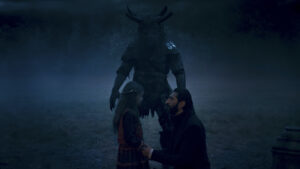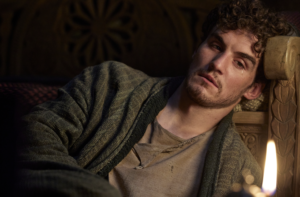MINOR SPOILERS FOR THE WHEEL OF TIME SEASON 2, EPISODES 1 – 3 AHEAD!
This piece was written during the 2023 WGA and SAG-AFTRA strikes. Without the labor of the writers and actors currently on strike, the series being covered here wouldn’t exist.
I wrote once that The Wheel Of Time‘s season one finale was a necessarily messy episode of television, having to hurriedly clear pieces off the board and wipe it clean so that season two could jump into a new game in a new setting (narratively and thematically as well as physically), and no longer be burdened with the consequences of working around COVID-19, star Barney Harris’ sudden departure, and the occasional incoherence of the source material itself, which piled up in the back-half of season one and threatened to bog down what was otherwise an enjoyable, fast-paced trek along the margins of Robert Jordan’s expansive world. Nearly two years later, I am pleased to report that my prediction has come to pass, as surely as any of Min Farshaw’s foretellings. The Wheel Of Time hits the ground running in its second season specifically because of the dirty work done in season one, episode eight.

The choice to depower Moiraine Damodred (Rosamund Pike) at the Eye of the World, controversial at the time, is one that forces Pike to resituate herself in her character’s fundamentally altered body and mind, and to which the Oscar-nominated actress responds enthusiastically by punching jagged holes in the façade of unreadable micro-expressions and mannerisms that Moiraine was accustomed to using as a shield, gaps in her defenses through which her raw humanity now spills in angry torrents, deliberately aimed to hurt the one person staying and trying – in his eyes, harder than Moiraine herself has ever tried – to patch up her wounds, who will continue to fail and hurt himself in the process as long as he refuses to acknowledge that these wounds run far too deep for him to heal; her loyal Warder, al’Lan Mandragoran (Daniel Henney). The more Lan tries to force Moiraine to talk through her grief, the more she pulls away from him and the wider the rift between them grows. They can’t get on the same page without the Bond to guide them in the right direction, and so in the first episode’s final minutes Moiraine runs, deeming it safer for them both if she does, only to have all her fears and doubts confirmed when Lan follows and nearly kills himself to protect her. The devolution of what once seemed an indestructible relationship founded in mutual trust is the episode’s central through line, around which all other plot-threads must loosely swirl, reflecting how the characters find themselves being buffeted by the winds of change to far-flung corners of the world at the beginning of season two.
But the wind lifts each of these threads and binds them to the others before episode’s end in a sequence that appropriately brings the Wheel of Time almost full-circle, as Bel-Tine lanterns last lit on the fateful night before the Emond’s Field Five left home – a year earlier, in-universe – now flicker once again on a stream in Arad Doman where Perrin Aybara (Marcus Rutherford) makes camp alongside Shienaran soldiers, on the stone windowsill of a room in the White Tower where Egwene al’Vere (Madeleine Madden) and Nynaeve al’Meara (Zoë Robins) find fleeting moments of comfort amidst their grueling training, and on a street-corner in the scaffolding-encased city of Cairhien where Rand al’Thor (Josha Stradowski), the Dragon Reborn, waits patiently for madness to consume his soul. Dónal Finn’s Mat Cauthon, meanwhile, makes do without a lantern in the White Tower dungeon where we find him languishing, months after he abandoned his friends to go after a cursed dagger. Wherever these places are in relation to each other and Emond’s Field (and, for the viewer unfamiliar with a map of the Westlands, there really isn’t any indication), this scene forcefully reiterates that home is never far from any of our main characters’ hearts, and that right now, more than anything, they yearn for what they’ve lost.
With the exception of Rand, who doesn’t appear again until episode two, each of these characters, and Moiraine and Lan, face challenges in the premiere that test how far they’re willing to go, and what they’re willing to lose, to become the heroes they need to be if they’re to have any hope of winning the coming Last Battle – and no one is feeling the pressure more than Nynaeve, the most powerful channeler to train at the White Tower in a thousand years, who has subconsciously developed a ‘block’ that prevents her from channeling except in moments of extreme anger, fear, and sorrow. Every Aes Sedai in the Tower craves the prestige that would come from being the one to break Nynaeve’s block and guide her to greatness, making all their efforts to help seem insincere, but the one who finally coaxes a reaction out of her during a particularly brutal session is also the one Nynaeve trusts the least; Liandrin Guirale (Kate Fleetwood) of the authoritarian Red Ajah, a woman who represents everything Nynaeve detests most about the Aes Sedai and their White Tower.
To say that Fleetwood is a standout from the first three episodes would be an understatement. She is utterly electrifying, and no one on The Wheel Of Time, with the exception of Fleetwood’s frequent scene-partner Zoë Robins, is more deserving of critical recognition for their work this season (and we will talk about Robins in my review of episode three), though all the cast are perhaps equally worthy and there are several others I’d single out for praise in the first episode alone, including Madden, who brims with charisma; Rutherford, who has settled comfortably into a middle-ground between learned stoicism and innate vulnerability after being emotionally paralyzed by the narrative for much of season one; and the delightful pairing of Meera Syal and Nila Aalia as exasperated eccentric Verin Mathwin and playful flirt Adeleas, Aes Sedai of the Brown Ajah who inject energy into Moiraine’s slow-paced storyline. Dónal Finn, who I will highlight in my review of episode two, quickly joins the likes of Robins, Fleetwood, and Pike with a performance I can only describe as enthralling.
With the younger members of the cast having each developed a strong, distinctive acting-style and synergizing effortlessly with each other and the veterans of stage and screen who surround them, the responsibility of carrying The Wheel Of Time can now be shared more evenly amongst them all, and I’m sure that after dedicating so much of her time in recent years to the character of Moiraine, there must be a part of Rosamund Pike that welcomes the opportunity to take a step back and proudly witness that transition occur. With that said, she is likely to continue serving as the series’ iconic mascot as long as her name alone can pull in new viewers, and it would be criminal in any case to neglect an actress of her caliber, or even expect her to be content with the relatively small and insignificant role her character plays in The Great Hunt and The Dragon Reborn, the second and third books in Robert Jordan’s monumental fourteen-volume series. Finding an appropriate balance going forward will surely be the hardest task facing showrunner Rafe Judkins, though to date, fleshing out Moiraine’s storyline with material derived from the prequel novel New Spring, including information about her early years that sadly never became relevant in the main series, has proven a satisfying workaround and opens new pathways that ultimately connect her back to Rand and other characters.
The very notion of changes to the order of events in the books is understandably nerve-wracking to some, and blasphemous to others, but while there are major changes, each and every one has been made with the essence of the characters in mind…and what’s more, even changes that could not have been avoided are executed in such a way that they could not feel more organic. For example, it’s Perrin, instead of Rand, who has the closest relationship with Ingtar Shinowa (Gregg Chilingirian, quietly exceptional in the role), and while on the surface it’s a change that could seem random, a product of circumstances more than anything else, a closer reading of Ingtar’s words to Perrin near the end of episode one as the two discuss Padan Fain (Johann Myers)’s motivations for joining the Dark reveals that it’s an exquisite adjustment made to service both their arcs in ways I can’t wait to explain after the season finale (no spoilers in the comments, please!). And remember, this beautiful scene wouldn’t exist were it not for Perrin being the one to awkwardly run into Fain in Fal Dara last season solely because someone had to fill Mat’s place.

And that brings me to an even better example, which is, of course, Mat’s entire storyline this season. While it was never planned or predicted that Barney Harris would leave The Wheel Of Time midway through filming season one, necessitating that his character be written off the show temporarily with a myriad of clumsy excuses, you wouldn’t guess it from the way it’s been gracefully handled in season two. I feel safe in stating that there’s nothing Mat does in the first three books that would have more perfectly illustrated to the audience exactly who he is and everything he struggles with than what Judkins came up with as a hasty backup plan for his character. To pull that off, as well as the recasting, in the middle of a pandemic, must have required a coalescence of imagination and ingenuity Hollywood can never hope to replicate with an AI.
Outstanding actors working from an excellent script could convince the audience that any four walls are a palace or a prison, but The Wheel Of Time is an epic fantasy greater in scale than almost any other, and that wasn’t always evident from the first season, which could only afford to visit three or four primary locations across eight episodes, with about the same number of outfits for each main character, or fewer. But an evidently sizable expansion to the series’ budget has allowed the production designers, costume designers, hairstylists, makeup artists, and propmakers in every field and art-form to go absolutely wild this season, filling every nook and cranny of this world with detailing pulled straight from the books. The White Tower, so obviously a single soundstage decorated slightly differently for various scenes in the first season, now feels like an entire ecosystem nestled in the beating heart of Tar Valon, itself much larger and more vibrant this season. The women of the Aes Sedai not only dress like actual people instead of being restricted to the color of their respective Ajah, they also dress fabulously, in patterned silks, laces, velvets, and furs, bedecked in precious stones and metals – everything I was missing from their introduction in season one, essentially. If costume designer Sharon Gilham alone walks away with an Emmy for her work this season, it will not be enough but nor will it be undeserved.
On a similar note, the CGI has improved substantially between seasons and the ‘weaves’ constructed by channelers from glinting threads of the One Power are far more intricate now, containing colors besides cloudy white, including vivid shades of gold, silver, and amber. These threads wind differently for each woman (and man), some as vague and ethereal as ribbons swirling in a breeze, some as sharply defined and precise as the razor-edged cord of a garrote. Nynaeve, because of her block, tends to channel messily when she channels at all, and her weaves are loose, ragged. Liandrin has a dexterity with the Power we have yet to see matched by any channeler save the Forsaken Ishamael (Fares Fares), her weaves forming long, thrashing whips. And Egwene…well, Egwene has been teaching herself to channel without the use of her hands, and we finally see her do so in episode three, though her weaves of sinuous flame are easily extinguished by Liandrin. It’ll be quite interesting to see how Moiraine uses the Power, assuming she’s unshielded by Rand or Siuan this season (I have no doubt in my mind she’s shielded, not stilled, as she seems to believe).
Even with an increased budget, however, I would never say that The Wheel Of Time relies at any point on its CGI, and in fact the continued use of practical effects wherever possible is perhaps one of the series’ most exciting and endearing qualities from a filmmaking perspective. In the first episode’s climactic action sequence, Moiraine is ambushed on the road by three Fades, the most vaguely humanoid of Shadowspawn. Bereft of the abilities she would ordinarily use to fight back, she hides for a moment to weigh her options, draws a knife, and begins stalking her unseen enemies through patches of shadow on the ground. The resulting battle is shot and choreographed to seem totally, brutally grounded, something I think is largely attributable to the fact that you can feel the presence of every actor and stunt performer in the scene, the weight and impact of every sword-thrust, kick, and hit. The Fades feel like a real threat because they are real, making their unnerving speed and strength more incredible, and their weaknesses more believable.
The season’s primary antagonists, Ishamael and Padan Fain, are relegated to small roles in the suspense-driven first episode, which allows our anticipation to grow with each passing moment that we know and the characters know that they’re just off-camera, observing quietly. Fain is one of the book series’ most terrifying villains, his deeds in service to the Dark downright stomach-turning, and I feel that was captured in the early scene where Perrin and the Shienarans come across the wreckage of a Tuatha’an caravan and the bodies of several Darkfriends killed by Fain for no other reason than to whittle down his competition. Perrin’s wolf-senses allow him to relive the carnage as it happened (interestingly, the girl that he sees escaping the massacre, whose fate is still unknown, is the very same girl who befriended Ishamael in the cold-open), further deepening his distaste for violence, his discomfort in his own body, and his distrust of Elyas Machera (Gary Beadle), the golden-eyed “sniffer” who shares his abilities. While it would have been nice to see Elyas in the first season, holding off his introduction meant effectively isolating Perrin, giving him more legitimate reasons to build barriers between himself and the wolves that we’ll see him topple gradually, reluctantly, over the course of this season.
If there is any cause for concern to be found in the first episode, it is the absence of Sophie Okonedo, who appears to have only filmed an episode or two as Siuan Sanche, the Amyrlin Seat of the Aes Sedai, greatly reducing both the amount of time we can expect her to share with Egwene and Nynaeve this season (if any), and her potential future involvement in storylines at the White Tower that…revolved around Siuan in the books. With the character of Elaida yet to be introduced, however, it seems those storylines may not be established at all until season three, which I think is a terrible mistake. Then again, if Mat’s character arc could be resuscitated and restored to full health in the span of a few minutes with Dónal Finn, I have faith that Sophie Okonedo and whichever extremely talented actress is cast as Elaida can convince me of their decades-long rivalry in no time at all.

In short, the first episode of season two finally elevates the series a step above season one – and above most of the competition – in every way. The Wheel Of Time is even more epic and more thrilling in this Turning, its cast even stronger, its worldbuilding even richer. There is no comparing the two seasons, really, because the difference is night and day, and I say that as someone who enjoyed most of the first season and still rewatches my favorite episodes, three, five, and six, frequently. Season one was good, at times great, and offered fleeting glimpses of what The Wheel Of Time could be. Season two is phenomenal television that finally lives up to what was promised, and doesn’t waste a second of screentime in doing so.
Episode Rating: 9/10